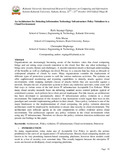An Architecture for Detecting Information Technology Infrastructure Policy Violations in a Cloud Environment

View/
Date
2018-10-14Author
Oginga, Ruth Anyango
Musau, Felix
Maghanga, Christopher
Metadata
Show full item recordAbstract
Organizations are increasingly becoming aware of the business value that cloud computing
brings and are taking steps towards transition to the cloud. Just like any other technology it
brings new security threats and challenges. A smooth transition entails a thorough understanding
of the benefits as well as challenges involved. Privacy is a concern that has risen as obstacle to
widespread adoption of clouds by users. Many organizations consider the deployment of
different types of protection systems to curb the various malicious activities. The systems can
offer sophisticated monitoring and reporting capabilities to identify attacks against cloud
environment, while stopping multiple classes of attacks before they are successful against a
network. Despite the use of protection systems to detect any malicious activities, some users still
find ways to violate some of the laid down IT infrastructure Acceptable Use Policies. While
many cloud security research focus on enforcing standard access control policies typical of
centralized systems, such policies have often proved inadequate. For this reason, an architecture
has been developed to automatically detect IT infrastructure policy violation in a cloud
environment The implication of this research is that institutions would regain their trust in this
paradigm and consider implementing policies in their clouds. Since policy violation is one of the
major hindrances to the implementation of cloud computing, the policy violation detection
architecture could be employed by institutions to ensure data security in cloud environment. The
architecture uses software agents as its core components to collect evidence across cloud
environment. The architecture captures any policy violation in the cloud environment when
using any IT infrastructure. Therefore we discuss the policy violation detection architecture and
present our findings in this paper.
